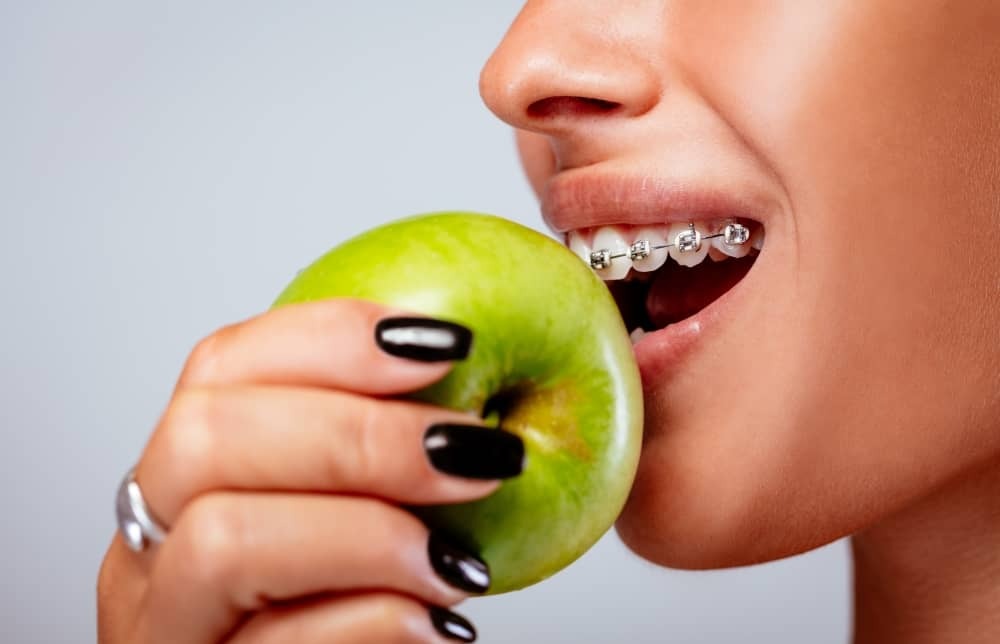No products in the cart.
The first week with braces can be a bit challenging as your teeth and mouth adjust to the new hardware. It’s common to experience soreness, tenderness, and discomfort during this time, making it essential to choose foods that are soft, easy to chew, and gentle on your teeth. Proper care during this period will also help you avoid damaging your braces and ensure a smooth adjustment process.
Here’s a comprehensive guide on what to eat during the first week of wearing braces, along with tips on managing discomfort and maintaining oral hygiene.

Best Foods to Eat During the First Week
During the first week with braces, focus on soft foods that don’t require much chewing or force. Here are some ideal food options:
1. Smoothies
Smoothies are a great option because they’re not only soft but also nutritious. You can pack a smoothie with fruits, yogurt, milk, or even protein powder to make it a filling and healthy meal. Avoid seeds, nuts, or hard ingredients like ice that might be difficult to consume with braces.
2. Mashed Potatoes
Mashed potatoes are soft, comforting, and easy to eat, making them a popular choice during the first week. You can add gravy, butter, or sour cream for extra flavor without making it tough on your braces.
3. Yogurt
Plain or flavored yogurt is easy to eat and doesn’t require any chewing. Opt for smooth yogurt without fruit chunks or seeds, as these can get stuck in your braces. Greek yogurt can also be a good choice for added protein and creaminess.
4. Scrambled Eggs
Eggs are an excellent source of protein and can be cooked in various soft forms. Scrambled eggs, omelets, or poached eggs are easy to chew and won’t irritate your teeth or braces. You can add cheese or soft veggies like spinach for added flavor.
5. Oatmeal or Cream of Wheat
Both oatmeal and cream of wheat are warm, comforting, and soft, making them great for breakfast during the first week of braces. You can add mashed bananas, honey, or cinnamon for extra taste. Be sure to cook them thoroughly to ensure they’re soft enough to eat comfortably.
6. Pasta and Soft Noodles
Pasta, especially when cooked until soft, is a braces-friendly food. You can try mac and cheese, soft ravioli, or plain pasta with a mild sauce. Avoid anything too crunchy, like hard bread or croutons in pasta dishes.
7. Soup and Broth
Soups are nourishing and gentle on sore teeth. Opt for creamy soups like tomato, pumpkin, or butternut squash soup. Chicken noodle or vegetable broth with soft vegetables is also a great option. Be sure to avoid soups with hard chunks of meat or crunchy croutons.
8. Bananas and Applesauce
Bananas are soft, sweet, and easy to eat without much chewing. Applesauce is another excellent option, especially if you want something light and easy to digest. Both are healthy and gentle on your teeth.
9. Soft Cheese
Cheese can be an easy, soft snack to enjoy. Soft varieties like cream cheese, cottage cheese, and mozzarella are particularly easy to eat. These provide protein and calcium while being gentle on tender teeth.
10. Pudding and Custard
Pudding and custard are sweet treats that are soft and require no chewing. They are great desserts during the first few days, offering comfort without causing discomfort.
11. Avocados
Avocados are smooth and soft, making them a good option for those with braces. They can be eaten on their own, mashed, or blended into a smoothie. Avocados are also rich in healthy fats, vitamins, and minerals, making them both nutritious and easy to consume.
12. Soft Fish
If you’re looking for a protein source beyond eggs, soft fish like salmon or tilapia can be a good choice. These fish are tender and flaky, which makes them easy to eat with minimal chewing. Avoid any crispy or fried varieties.
Foods to Avoid During the First Week
As your mouth adjusts to braces, it’s crucial to avoid hard, sticky, and chewy foods that can cause damage or discomfort. Here’s a list of what to steer clear of:
- Hard or Crunchy Foods: Avoid foods like raw vegetables, chips, pretzels, nuts, or crusty bread, as they can damage your braces or cause discomfort.
- Sticky Foods: Chewy candies, caramels, or gum can get stuck in your braces and are difficult to clean. They can also pull on your brackets and wires, causing damage.
- Tough Meats: Steak, pork chops, and other tough cuts of meat can be difficult to chew. Opt for softer options like shredded chicken or fish.
- Whole Fruits and Vegetables: While fruits and vegetables are essential for a balanced diet, avoid biting into hard fruits like apples or crunchy veggies like carrots. You can eat them by cutting them into small pieces or steaming the vegetables to soften them.
- Chewy Bread or Bagels: These can be hard to chew and might cause discomfort in the early stages of wearing braces.
Managing Discomfort
It’s normal to feel some soreness and discomfort during the first week as your teeth begin to adjust to the braces. Here are some tips for managing discomfort:
- Use Pain Relievers: Over-the-counter pain relievers like ibuprofen or acetaminophen can help reduce soreness and pain.
- Apply Orthodontic Wax: Your orthodontist will likely provide you with wax to place on the braces where they might be rubbing against your cheeks or lips. This can prevent irritation and sores.
- Cold Foods and Drinks: Cold smoothies, chilled water, or ice cream can soothe sore gums and teeth, providing temporary relief.
- Rinse with Salt Water: A warm saltwater rinse can help alleviate any irritation or discomfort in your mouth. Mix about a teaspoon of salt in warm water and gently swish it around in your mouth for 30 seconds before spitting it out.
Maintaining Oral Hygiene
While it’s essential to eat soft foods, maintaining excellent oral hygiene is equally crucial with braces. Food particles can easily get trapped in the brackets and wires, so brushing and flossing after every meal is important.
- Brush carefully: Use a soft-bristled toothbrush and take your time to clean around the brackets and wires.
- Use interdental brushes: These small brushes can help clean between braces where a regular toothbrush might not reach.
- Floss daily: It can be more challenging to floss with braces, but there are special orthodontic flossers and threaders available to make the process easier.
By sticking to soft foods and being mindful of your oral care routine, you can ensure a smooth transition into your new braces, minimizing discomfort while keeping your teeth and braces in good condition.
